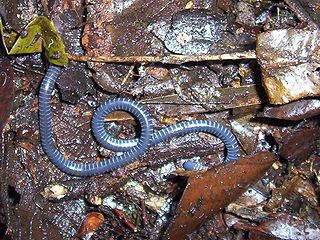
Ichthyophis garoensis, the Garo Hills caecilian, is a species of caecilian found in Assam and Meghalaya in north-eastern India. The Husain's caecilian Ichthyophis husaini was until 2016 considered a separate species. It is a subterranean caecilian that lives in the moist leaf-litter of tropical forests. It is typically found close to streams and other waterbodies.
Uraeotyphlus malabaricus is a species of caecilian in the family Ichthyophiidae. It is endemic to the Western Ghats of India and is known from its type locality, "Malabar" in Kerala, and from the Nilgiri mountains in Tamil Nadu. It is known with several common names: Malabar tailed caecilian, Nilgiris caecilian, Malabar caecilian, and white-lipped caecilian.
Gegeneophis carnosus is a species of caecilian found in Karnataka and Kerala states, India. Its common name Periah Peak caecilian refers to its type locality, though it is also known under names blind caecilian and pink blind caecilian.
Gegeneophis danieli, the Amboli caecilian or Daniel's caecilian, is a species of caecilians in the family Indotyphlidae. It was discovered from near Amboli in Western Ghats of Maharashtra.
Gegeneophis madhavai, the Mudur caecilian, is a species of caecilian found in India. It is only known from its type locality Mudur village, Kundapura Taluk in Udupi district in Karnataka.
Gegeneophis krishni, the Gurupur caecilian, is a species of caecilian found in India. It is only known from its type locality Gurupur, near Mangalore in Karnataka, India.
Gegeneophis ramaswamii, common names Tenmalai caecilian, Tenmalai blind caecilian, Ramaswami's caecilian, and forest caecilian is a species of caecilian. It is endemic to the southern portion of the Western Ghats, India, and is recorded from Kerala and Tamil Nadu. The specific name ramaswamii honours L. S. Ramaswami, an Indian herpetologist.
Battersby's caecilian is a slender species of caecilian endemic to the Western Ghats, India. It has a flesh-coloured body, making it look very much like a large earthworm.

Boulengerula taitana is a species of caecilian. It is endemic to the Taita Hills region of southeast Kenya.

Ichthyophis orthoplicatus, also known as the Pattipola caecilian or brown caecilian, is a species of caecilian endemic to Sri Lanka. It is found in a range of natural and man-made habitats including evergreen forests, rubber and tea plantations, paddy fields, rural gardens and farms, wetlands, and cattle pastureland.

The Western Ghats in India are home to several species of caecilians (Gymnophiona). Caecilians are legless, burrowing amphibians which mostly live in leaf litter, loose soil, under rocks and decaying logs. They are also found in agricultural fields and only surface during the monsoon. The body is elongated and smooth with a slimy skin. The smaller caecilians superficially resemble earthworms while the larger ones are often mistaken for snakes. However, they can be told apart from earthworms by the presence of eyes, teeth and skeleton and from snakes by the lack of scales on skin. The eyes in caecilians are not well developed which is most likely to be because of their burrowing life style. They are considered as rare which is apparently due to their subterranean habits. To see them one has to search carefully and be at the right place and at the right time. There are few places where they are common, but, at least one species was reported to be abundant in agricultural fields in Kerala. The larger caecilians can resemble snakes, but their skin is smooth, not scaly.
Caecilia dunni is a species of caecilian in the family Caeciliidae. It is endemic to Ecuador and known from the Amazon basin in Napo and Pastaza Provinces. The specific name dunni honors Emmett Reid Dunn, a prominent American herpetologist. Common name Dunn's caecilian has been coined for it.
Caecilia mertensi is a species of caecilian in the family Caeciliidae from South America. The type locality is imprecise: the holotype was purportedly collected in "Seychelle Isle", but most likely originates from South America. However, more recently, several specimens have been collected from Mato Grosso, Brazil. The specific name mertensi honors Robert Mertens, a German zoologist and herpetologist. Common name Mertens' caecilian has been coined for this species.
Gegeneophis is a genus of amphibians in the family Indotyphlidae. They are found in southern and northeastern India.
The Indotyphlidae are a family of common caecilians found in Africa, Seychelles and India. Like other caecilians, they superficially resemble worms or snakes.
Gegeneophis primus is a species of caecilian discovered in Wynad district in the Western Ghats of Kerala, India. The species was described in 2012 by Ramachandran Kotharambath, Mark Wilkinson, and colleagues.
Gegeneophis goaensis, also known as the Goa caecilian, is a species of caecilian known from its type locality in Keri Village, Sattari Taluk, in the North Goa district of Goa, India.
Bagepalli Ramachandrachar Seshachar was a renowned zoologist and the President of Indian National Science Academy from 1971–72.




